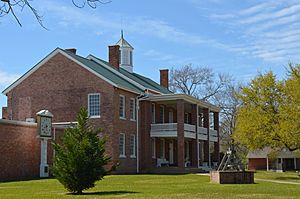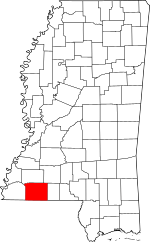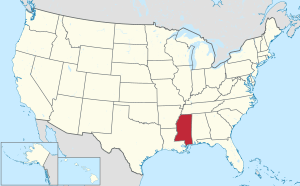Amite County, Mississippi facts for kids
Quick facts for kids
Amite County
|
|
|---|---|

Amite County courthouse in Liberty
|
|

Location within the U.S. state of Mississippi
|
|
 Mississippi's location within the U.S. |
|
| Country | |
| State | |
| Founded | 1809 |
| Named for | Amite River |
| Seat | Liberty |
| Largest town | Gloster |
| Area | |
| • Total | 732 sq mi (1,900 km2) |
| • Land | 730 sq mi (1,900 km2) |
| • Water | 1.5 sq mi (4 km2) 0.2% |
| Population
(2020)
|
|
| • Total | 12,720 |
| • Density | 17.377/sq mi (6.709/km2) |
| Time zone | UTC−6 (Central) |
| • Summer (DST) | UTC−5 (CDT) |
| Congressional district | 3rd |
Amite County is a county located in the state of Mississippi on its southern border with Louisiana. As of the 2020 census, the population was 12,720. Its county seat is Liberty. The county is named after the Amite River, which runs through the county.
Amite County is part of the McComb, MS Micropolitan Statistical Area.
Contents
History
After Indian Removal in the 1830s, white European-American migrants developed the county for cotton plantations, worked by African-American slaves. As a result, the county population was majority black before the American Civil War. White planters did well during the cotton boom, and cotton was the basis of the economy until the 1930s.
Amite County was not in a theater of war of the American Civil War. A raiding party of Union cavalry under the command of Colonel Benjamin Grierson is known to have camped in the county nine miles east of Liberty on the evening of 28 April 1863 while conducting a deep penetration raid as part of the Vicksburg Campaign.
At the end of the Civil War, Amite County's population was 60% African American. During Reconstruction, freedmen elected several African Americans to local office as county sheriff. After Reconstruction, white Democrats regained power in the state legislature through a combination of violent voter repression and fraud. They disenfranchised most African Americans and many poor whites in the state by the new 1890 state constitution, which imposed a poll tax, literacy tests, and other requirements as barriers to voter registration. These were administered by whites in a discriminatory way. Most black voters and many poor whites were dropped from the voter rolls. African Americans were a majority in the state until the 1930s. Excluded from voting, they were also excluded from juries and the entire political system.
The county continued to be based on agriculture, shifting to logging and dairy farming in the 1930s. As agriculture was mechanized, reducing the need for farm labor, many blacks left Amite County during the early 20th century in two waves of the Great Migration. In the first wave many moved north to Chicago and other industrial cities of the Midwest. In the second wave, they moved to the West Coast, where the burgeoning defense industry in California particularly created jobs. From 1940 to 1960, the county population declined by 29%, as can be seen on the census tables below. Some rural whites also left the county.
In the 1950s, local farmer E.W. Steptoe founded a chapter of the National Association for the Advancement of Colored People (NAACP) in the county, and Herbert Lee, a married farmer with nine children, was among its charter members. They were working to regain civil rights, including the ability to vote. In the summer of 1961, Robert Parris Moses from the Student Nonviolent Coordinating Committee worked in the county to organize African Americans for voter registration. He was beaten by Bill Caston, a cousin to the sheriff, near the courthouse, and arrested. He was told to leave the county for his own safety. In the 1960s, only one African American of the total of 5,500 in Amite County was a registered voter. Even after the Voting Rights Law was passed in 1965, grassroots efforts were required to register eligible voters.
Racial violence against blacks in the county escalated during the years of the Civil Rights Movement.
Following the repression of the civil rights era and a continuing poor economy, younger African Americans continued to leave the county, seeking jobs in bigger cities. The population declined more than 11 percent from 1960 to 1970, and further declines occurred to 1980 (see census tables below.) Because of the murders of Lee and Allen, voter registration efforts had stopped in the early 1960s. African Americans did not register until after passage of the Voting Rights Act of 1965, which provided federal protection and oversight. Today the county is majority white in population.
Noted historic sites listed on the National Register of Historic Places include the Amite County Courthouse and the Westbrook Cotton Gin, the only one surviving of seven in the county. In addition 19th-century plantation houses and the Liberty and Bethany Presbyterian churches are included on the Register.
Geography
According to the U.S. Census Bureau, the county has a total area of 732 square miles (1,900 km2), of which 730 square miles (1,900 km2) is land and 1.5 square miles (3.9 km2) (0.2%) is water.
Major highways
Adjacent counties
- Franklin County (north)
- Lincoln County (northeast)
- Pike County (east)
- Tangipahoa Parish, Louisiana (southeast)
- St. Helena Parish, Louisiana (south)
- East Feliciana Parish, Louisiana (southwest)
- Wilkinson County (west)
National protected area
- Homochitto National Forest (part)
Demographics
As mechanization of agriculture decreased the need for farm labor, the population has dropped since its peak in 1910 as people left in search of work in other areas. Continuing urbanization and suburbanization in other areas has also drawn people to cities of more opportunity.
| Historical population | |||
|---|---|---|---|
| Census | Pop. | %± | |
| 1810 | 4,750 | — | |
| 1820 | 6,853 | 44.3% | |
| 1830 | 7,934 | 15.8% | |
| 1840 | 9,511 | 19.9% | |
| 1850 | 9,694 | 1.9% | |
| 1860 | 12,336 | 27.3% | |
| 1870 | 10,973 | −11.0% | |
| 1880 | 14,004 | 27.6% | |
| 1890 | 18,198 | 29.9% | |
| 1900 | 20,708 | 13.8% | |
| 1910 | 22,954 | 10.8% | |
| 1920 | 18,960 | −17.4% | |
| 1930 | 19,712 | 4.0% | |
| 1940 | 21,892 | 11.1% | |
| 1950 | 19,261 | −12.0% | |
| 1960 | 15,573 | −19.1% | |
| 1970 | 13,763 | −11.6% | |
| 1980 | 13,369 | −2.9% | |
| 1990 | 13,328 | −0.3% | |
| 2000 | 13,599 | 2.0% | |
| 2010 | 13,131 | −3.4% | |
| 2020 | 12,720 | −3.1% | |
| U.S. Decennial Census 1790–1960 1900–1990 1990–2000 2010–2013 2020 |
|||
From a peak of population in 1910, the county had declined through 1990. In the early part of the 20th century, particularly from 1910 to 1930, and from 1940 to 1970, it was affected by the Great Migration of blacks out of the segregated society for jobs and opportunities in Midwest and later, West Coast cities. From 1910 to 1920, the population declined more than 17%, as may be seen from the Census table at right. Particularly in the early 20th century, Blacks left to escape the oppression and violence associated with Jim Crow, lynchings, and their disenfranchisement after 1890.
From 1940 to 1960, the population declined by more than 29%. Rural whites also left in those years, but a much greater number of African Americans migrated to other areas. After 1930 they became a minority in the county. In 2000, they constituted nearly 43% of the population.
2020 census
| Race | Num. | Perc. |
|---|---|---|
| White (non-Hispanic) | 7,434 | 58.44% |
| Black or African American (non-Hispanic) | 4,835 | 38.01% |
| Native American | 25 | 0.2% |
| Asian | 31 | 0.24% |
| Other/Mixed | 266 | 2.09% |
| Hispanic or Latino | 129 | 1.01% |
As of the 2020 United States census, there were 12,720 people, 5,218 households, and 3,401 families residing in the county.
2010 census
As of the 2010 United States Census, there were 13,131 people living in the county. 57.7% were White, 41.3% Black or African American, 0.2% Native American, 0.1% Asian, 0.2% of some other race and 0.6% of two or more races. 0.8% were Hispanic or Latino (of any race).
Communities
Towns
- Centreville (mostly in Wilkinson County)
- Crosby (partly in Wilkinson County)
- Gloster
- Liberty (county seat)
Unincorporated communities
Ghost town
Notable people
- L. C. Bates, African-American civil rights activist and the husband of Daisy Bates
- Robert P. Briscoe, World War II Navy Cross recipient and US Navy four-star Admiral
- Will D. Campbell, white Baptist minister, author, and civil rights activist
- Jerry Clower, country comedian
- J. C. Gilbert, member of Louisiana State Senate and Louisiana House of Representatives
- David Green, Mississippi state legislator and businessman
- Carl Augustus Hansberry, businessman and plaintiff in Hansberry v. Lee U.S. Supreme Court case; father of playwright Lorraine Hansberry
- William Leo Hansberry, scholar. Uncle of playwright Lorraine Hansberry
- Gabe Jackson, American football player for the Oakland Raiders of the National Football League (NFL)
- William F. Love, U.S. Representative from Mississippi
- T. T. Martin, evangelist and prominent figure in the anti-evolution movement in the 1920s; buried in Gloster
- Frank A. McLain, U.S. Representative from Mississippi
- Anne Moody, civil rights activist and author of Coming of Age in Mississippi
- Glenn Moore, softball coach
- Leon Perry, American football player
- Barney Poole, American football player
- Clyde V. Ratcliff, member of the Louisiana Senate from 1944 to 1948
- Andy Rodgers, Delta blues harmonicist, guitarist, singer and songwriter
- George H. Tichenor, inventor of an antiseptic, briefly lived and married in Liberty
- E. M. Toler, physician and coroner who served in the Louisiana State Senate from East and West Feliciana parishes
- Linda T. Walker, federal magistrate; judge for the United States District Court for the Northern District of Georgia
- James W. Washington, Jr., African-American painter and sculptor
- Franklin Delano Williams, Gospel music singer
- Damien Wilson, NFL player for the Dallas Cowboys
Images for kids
-
Illicium floridanum, Florida anise or stinkbush, a plant species endemic to the southeastern U.S.
-
Bottomland mixed hardwood-spruce pine forest along the West Fork Amite River
-
Stewartia malacodendron, or silky camellia, an uncommon species of the southeastern U.S.
See also
 In Spanish: Condado de Amite para niños
In Spanish: Condado de Amite para niños





